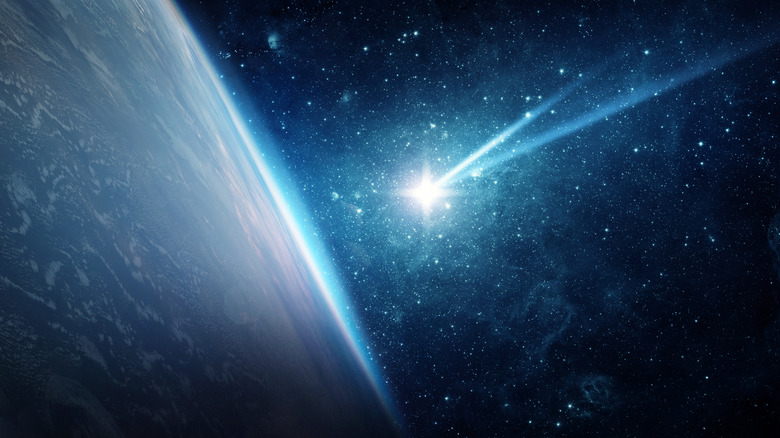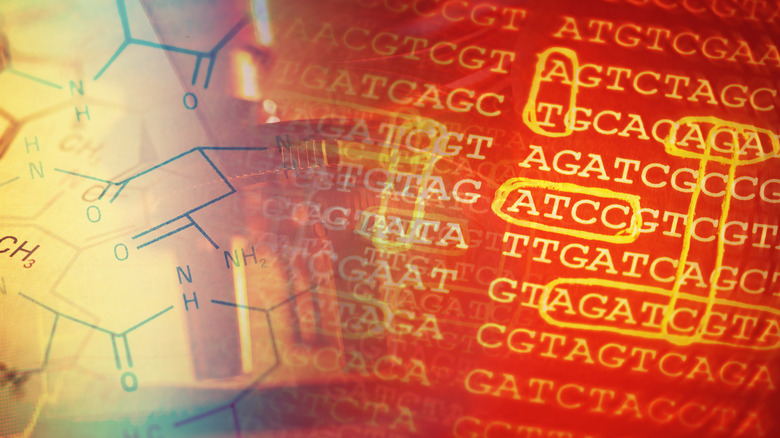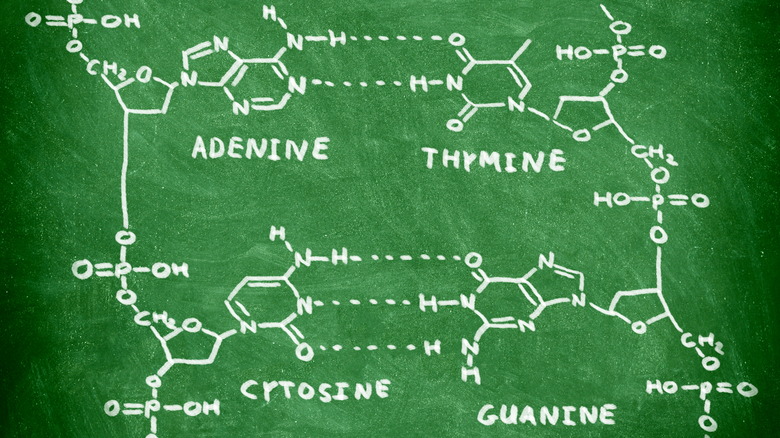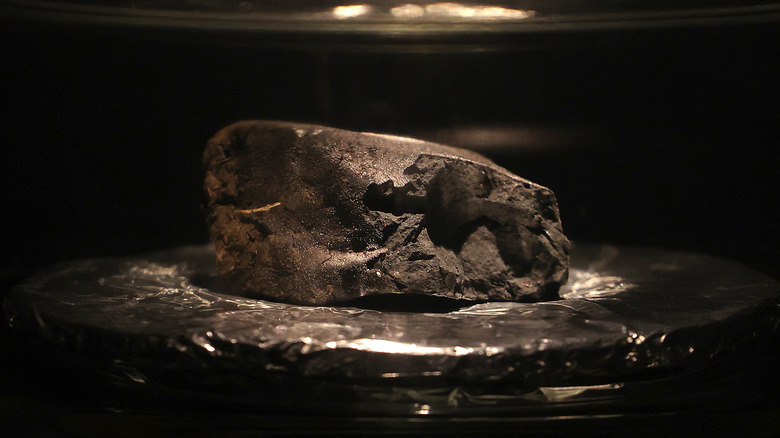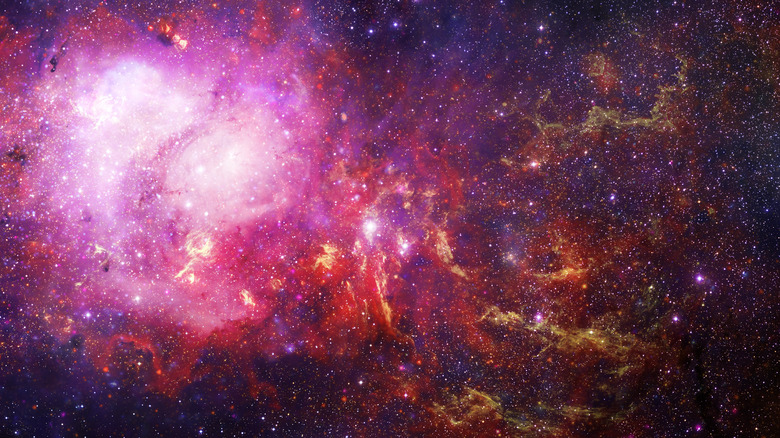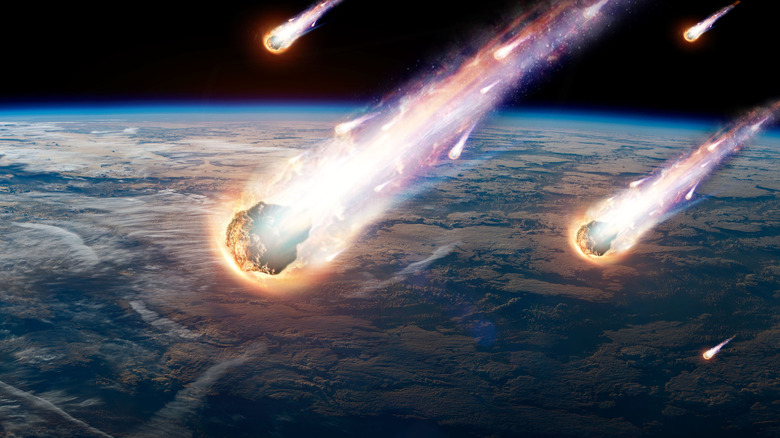New Research Could Prove A Link Between Humans And Aliens
By our nature, humans are a curious species. We always want to know the why and the what and the how of things. Our insatiable thirst for knowledge leads us to question everything from why does it rain to where does the sun go each night. And it turns out, given enough time, we're really good at answering these questions.
But some questions are so big and so profound that we're still working on finding the answers. One of those big questions is where did life come from, or as David Byrne of the Talking Heads so eloquently put it: "How did I get here?"
One theory is that a supernatural force is responsible for life in all of creation. Other theories posit a terrestrial origin for life, whether in the oceans of ancient Earth or in its primordial clay. One intriguing theory that's been seriously considered since the 19th century is that life or its building blocks come from outer space (via Live Science). And as far out as that sounds, there's some new research that makes this theory plausible.
Life came from the heavens
One thing that all life on Earth has in common is its foundation of DNA and RNA. Simply put, DNA is the instruction manual for how to make life, and RNA carries out the instructions (via Nature).
Chemically speaking, DNA and RNA are made of five different chemicals, called nucleobases. DNA and RNA are each made up of four nucleobases, three of them are in both, and two are unique to each. DNA is made up of adenine, thymine, cytosine, and guanine, abbreviated A, T, C, and G. RNA is similar, but swaps out uracil (U) for thymine (via Space).
Scientists looking for evidence of panspermia (the idea that the seeds of life came to us from outer space) have been looking in meteorites for clues. Specifically, they've been looking for these nucleobases. Until recently they've only been able to find adenine and guanine, but now, scientists using new high-resolution analysis techniques have found thymine, cytosine, and uracil in meteorite samples, meaning the literal building blocks of life are floating around in space right now (via Nature Communications).
Chemical cousins
One of the lingering mysteries this new research partially resolves is why only adenine and guanine had been found previously, and why the studied meteorites had higher quantities of adenine and guanine than the other three chemicals (via Space). One clue lies in the differing structures of the chemicals. Nucleobases can be divided into two general categories based on their chemical structure: purines and pyrimidines. Pyrimidines (thymine, cytosine, and uracil) contain a hexagonal chemical structure similar to benzene, only made up of nitrogen and carbon. Purines (adenine and guanine) are similar, but they have an additional pentagonal ring affixed to their hexagonal ring (via ThoughtCo).
Per Nature Communications, experiments simulating the environment of interstellar gas clouds have found that both purines and pyrimidines can be produced in outer space, but there was a greater abundance of purines in the meteorites the scientists studied. They're not sure why, but they speculate it's because of the pentagonal ring called imidazole. Imidazole and molecules based on imidazole were found in higher amounts in the studied meteorites, which implies that it is more readily synthesized in space.
Not just a rock
Even though space is mostly empty, there's still a lot of stuff up there, especially around solar systems. The general term for this stuff is meteoroid. When a meteoroid falls to earth its friction with the atmosphere causes it to light up and become a shooting star or meteor. If the meteor survives its fall to earth it's called a meteorite (via NASA).
Meteorites are a diverse group of space rocks, but they can be split into three broad groups: stony, iron, and stony-iron. The stony meteorites are further broken down into different groups, but the one we're interested in, and the ones studied by the scientists, are known as carbonaceous chondrites, due to their higher levels of carbon in the form of organic compounds (via National Geographic).
It's not just the organic compounds like amino acids and nucleobases that make these asteroids so rich for study. It's the fact that they are believed to have formed in the outer reaches of the solar system, directly from the original solar nebula, untouched by the heat of the inner solar system. That makes them perfect windows into the past, and lets us see the chemical composition of our galactic neighborhood before the formation of the planets (via Cosmos).
History of panspermia
The philosophical underpinnings beneath the idea of panspermia go back over 2,500 years, to the Greek philosopher Anaxagoras, who posited that the universe is filled with the seeds of life. But, according to Cosmos, there were three developments in the 19th century that made panspermia a valid topic for scientific discussion.
One was debunking the idea of spontaneous generation, whereby life arises spontaneously. Another was Darwin's theory that all life had a common ancestor. And the last one was the theory that the solar system arose in a nebula too hot for anything to live. Therefore, if the Earth was initially uninhabitable, and life can't arise from nothing, and we all came from the same source, from whence came that original life?
By the turn of the 20th century, notable scientists were coming out both for and against the idea that life could be seeded from outer space. The proponents of the idea emphasized its possibility and the idea that life could only be derived from other life. Its opponents focused on the harsh environs of space and the futility of searching for the origin of life (via Sudhoffs Archiv).
Theories of panspermia
One of the oldest theories of panspermia is radiopanspermia: the idea that microscopic lifeforms carried in dust grains can escape the atmosphere and be propelled out of the solar system by the solar wind. The problem with this theory is surviving the ultraviolet radiation of the sun, but scientists at the University of Waterloo have proposed that a microorganism could survive the journey out of the solar system if it hitched a ride during the red giant phase of a star's life cycle, making this theory improbable but plausible (via Journal of the Royal Astronomical Society of Canada).
Perhaps the most well-known theory is lithopanspermia, the possibility that life or its building blocks can be transported by catching a ride on a rock. We know that impacts on the moon and Mars can eject matter that falls to the Earth as meteorites. It's possible that a similar process could transport simple life from a living world to a dead but habitable world (via Universe Today).
We may find proof of this theory in our lifetimes. Scientists have run meteorite impact simulations that show it's possible that Earth-based debris from a meteorite impact could be launched as far as Jupiter's moon Europa. If such a collision happened early in Earth's history, before the oceans of Europa froze over, we could find life on Europa descended from early life on Earth.
